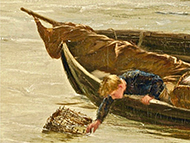
Viktor Vasnetsove, Flying Carpet (1919–1926, detail)
Flying
The Babbington Press (2020)
Paperback: 479 pages, $ 25.95
Hardcover: 479 pages, $ 29.95
Amazon Kindle: $5.99
Flying
Our Little Secret
I AM SOMETIMES asked to explain the secret of the happiness that Albertine and I have found in each other’s company over all the years that we have been together, through thick and thin and through thin and thinner, and when asked I admit quite frankly that the secret is our nearly perfect balance of induced and dynamic lift.
Lift, on a wing, on an airplane, is a matter of relative pressure: less pressure above, pressing down; more pressure below, pushing up. When the pressure’s off above and on below, we rise. I am a great believer in lift, unlike Wolfgang Langewiesche, who, in his Stick and Rudder: An Explanation of the Art of Flying, disparaged lift. It might be fair to say that Langewiesche pooh-poohed the whole idea of lift, coming very close to calling it an illusion, as close as Kurt Gödel came to calling time an illusion in “A Remark About the Relationship Between Relativity Theory and Idealistic Philosophy,” his contribution to the 1949 Festschrift volume, Albert Einstein: Philosopher-Scientist. For Langewiesche, the upward mobility of a forward-moving airplane is the result of the reaction of the undersurface of the wing to the force of the air below the wing when the airplane’s engine pushes the wing against the air below it at a sufficient angle of attack—that is, with a sufficient upward slant. The air pushes the wing up, in Langewiesche’s view, and the wing needn’t be an airfoil; it might as well be a sheet of plywood; it could be any plane surface at all. Hence, Langewiesche points out, the name of the vehicle itself, an air(borne) plane. So, which is it: the lowered pressure on the upside of an airfoil or the greater pressure on the underside of a plane at the proper angle of attack? (In certain circles, this is still the subject of lively debate.) For the answer, I turn to Pope and Otis, my quondam mentors Frank and Art:
When an airfoil is presented to the wind at a positive angle of attack, the impact of the air on the under surface of the airfoil produces lift. This kind of lift is called dynamic lift. [The] lift which comes from the reduced pressure of the air above an airfoil is called induced lift. The total lift is the sum of these values, which is merely the difference between the increased pressure below and the diminished pressure above the airfoil.
For Frank and Art, it’s not a case of either-or. Both the dynamic and induced forms of lift play their parts.
As it is in flight, so it is in life—my life with Albertine, at any rate.
When Albertine commences an undertaking, she assumes a positive angle of attack and thrusts herself forward, attacking that undertaking head-on, with power and purpose and a plan. The undertaking could be something as simple as a cross-country drive or as complex as “taking Peter out for an airing so that his outlook on life will be refreshed.” The result is the same: the woman produces lift. Her kind of lift is called dynamic lift.
When I commence an undertaking, I begin conducting thought experiments at once, and in a remarkably short time my head is in the clouds. My kind of lift is called induced lift.
Through the combined effects of dynamic and induced lift, Albertine and I manage to transport each other over many of life’s little obstacles. Ordinarily, she provides the dynamic lift, and I’m the simple airfoil, providing the induced lift. Together, we are a complex airfoil like the one described by Frank and Art.
|
|
|
|
|
|
|






Copyright © 2008 by Eric Kraft. All rights reserved. Photograph by Eric Kraft.
